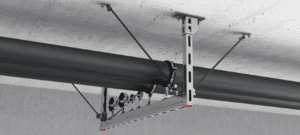Chemical nickel plating of seismic supports is a vital process that aims to improve the strength, durability and reliability of such components. It begins with preparation of the substrate surface, which involves cleaning and removing contaminants to ensure optimal adhesion of the nickel coating. This nickel layer provides a protective barrier against corrosion and increases the resistance of the substrate to vibration and seismic stress. The efficiency of chemical nickel plating of earthquake-resistant supports is set to improve further through technological advances and research in the field, ensuring greater safety and stability in earthquake-prone structures.

Table of Contents
ToggleWhen is chemical nickel plating of anti-seismic supports used?
Chemical nickel plating of earthquake-resistant substrates finds application in a wide range of contexts and structures, primarily those subject to seismic movements or intense vibrations.
Imagine a skyscraper in an earthquake zone: earthquake supports play a key role in keeping the structure stable during an earthquake, absorbing and dissipating seismic energy to minimize structural damage and protect human life. Similarly, in critical infrastructures such as bridges, hospitals, and nuclear power plants, the use of nickel-plated seismic supports can help ensure their resilience and safety in the event of a seismic event.
chemical nickel plating of earthquake-resistant substrates is used whenever it is necessary to ensure the stability and protection of structures during seismic events or intense vibrations, thus helping to preserve the safety and integrity of buildings and infrastructure around the world.
What are the advantages of applying nickel plating of earthquake-resistant supports?
The application of chemical nickel plating on earthquake-resistant substrates offers several significant advantages:
Chemical nickel plating: Corrosion protection
Nickel plating creates a protective layer on the surface of substrates, reducing exposure to corrosion caused by moisture, weathering and chemical processes. This extends the life of the media and reduces the need for maintenance.
Chemical nickel plating: Increased mechanical strength
The nickel layer adds strength to the structure of the supports, improving their ability to withstand mechanical stresses, including those caused by seismic events. This helps prevent the supports from breaking or failing during an earthquake.
Chemical nickel plating: Dimensional stability
Nickel plating helps maintain the dimensional stability of substrates over time, reducing the risk of deformation or damage caused by mechanical stress or temperature changes.
Chemical nickel plating: Less deterioration
Due to corrosion protection and increased mechanical strength, nickel-plated substrates tend to suffer little deterioration over time, providing more reliable and consistent performance over the long term.
Chemical nickel plating: Better vibration dissipation
The smooth and durable surface of the nickel-plated supports promotes better vibration dissipation, helping to reduce the amplification of seismic motion and protect the surrounding structure from damage.
In summary, the application of chemical nickel plating on seismic supports provides a combination of corrosion protection, improved mechanical strength, dimensional stability, less deterioration over time, and improved vibration dissipation, thus helping to ensure the safety and reliability of structures during seismic events.
In the future, how much will nickel plating of earthquake-resistant supports be used?
In the future, we can expect an increase in the use of nickel plating of earthquake-resistant supports as awareness of the importance of structural safety grows and technology continues to evolve. This increase in the use of nickel plating is motivated by several factors.
First, with the increasing seismic risk in many parts of the world, the need to protect structures from earthquake damage becomes increasingly critical. Nickel-coated earthquake supports offer an effective solution to increase the strength and stability of structures during an earthquake, thus helping to protect lives and property.
In addition, advances in technology and materials could lead to improvements in the quality and effectiveness of chemical nickel plating. New techniques and processes could make nickel plating more efficient, economical and environmentally friendly, making it an even more attractive choice for earthquake protection of structures.
Finally, the increasing adoption of stricter building regulations and standards could also encourage the widespread use of nickel plating of earthquake-resistant supports. Regulations requiring seismic risk assessment and mitigation could prompt engineers and designers to use solutions such as nickel-plated seismic supports to ensure compliance and safety of their structures.

